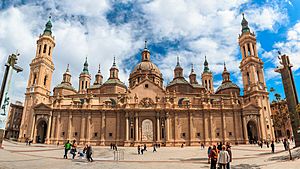Cathedral-Basilica of Our Lady of the Pillar facts for kids
Quick facts for kids Cathedral Basilica of Our Lady of the PillarCatedral-Basílica de Nuestra Señora del Pilar |
|
|---|---|
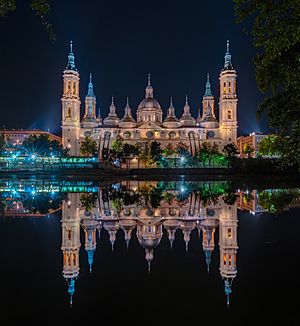
Nuestra Señora del Pilar Basilica
|
|
| Religion | |
| Affiliation | Catholic |
| Province | Archdiocese of Zaragoza |
| Rite | Roman Rite |
| Ecclesiastical or organizational status | Minor Basilica |
| Year consecrated | 1st or 2nd century AD (founded by the pre-Schism Christian Church) |
| Location | |
| Location | Zaragoza, Spain |
| Architecture | |
| Architectural style | |
| Groundbreaking | 1681 |
| Completed | 1961 |
| Type | Non-movable |
| Criteria | Monument |
| Designated | 22 June 1904 |
| Reference no. | RI-51-0000083 |
The Cathedral Basilica of Our Lady of the Pillar (in Spanish, Catedral-Basílica de Nuestra Señora del Pilar) is a famous Catholic church. It is located in the city of Zaragoza, which is in the Aragon region of Spain. This church is dedicated to the Blessed Virgin Mary. She is honored here as "Our Lady of the Pillar." Pope John Paul II even called her "Mother of the Hispanic Peoples." Many people believe this church was the very first one ever built to honor Mary.
Local stories say that this basilica's history goes way back to when Christianity first came to Roman Spain. It is said that Mary appeared to Saint James, one of Jesus's apostles. This is the only time Mary is believed to have appeared to someone before she was taken up into heaven.
Many kings of Spain, other rulers, and saints have visited this special statue of Mary. Famous saints like John of the Cross, Teresa of Ávila, and Ignatius of Loyola have prayed here. The Basilica of Our Lady of the Pillar is one of two important churches in Zaragoza. It shares the title of "co-cathedral" with another nearby church called La Seo de Zaragoza. The building is mostly in the Baroque style. Most of the current church was built between 1681 and 1872.
Contents
A Look Back in Time
The Story of the Pillar
According to a long-held local tradition, Saint James was preaching about Jesus in Spain. This was soon after Jesus's crucifixion and resurrection. Saint James felt sad because his mission was not going well. The story says that on January 2, 40 AD, while he was praying by the Ebro River, Mary appeared to him. She gave him a column made of jasper stone. She told him to build a church in her honor. She said, "This place is to be my house, and this image and column shall be the title and altar of the temple that you shall build."
The First Chapel
About a year after Mary's appearance, Saint James is believed to have built a small chapel. This was the very first church dedicated to Mary. After James went back to Jerusalem, he was killed around 44 AD. He was the first apostle to die for his faith. Some of his followers brought his body back to Spain for burial.
This first chapel was later destroyed, along with other Christian holy places. However, the special statue and the pillar were kept safe by the people of Zaragoza.
How the Church Grew
The Romanesque Church
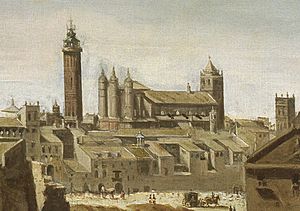
Many churches have been built on this spot over hundreds of years. The small chapel built by Saint James eventually became a larger church during the time of Emperor Constantine I. Later, it was rebuilt in different styles, including Romanesque, Gothic, and Mudéjar. The important holy sites in Zaragoza date back to when Christians took back the land from the Moors. This happened when King Alfonso I conquered Zaragoza in 1118. A church in the Romanesque style was built then. A carved stone panel from this Romanesque church can still be seen today.
The Gothic Church
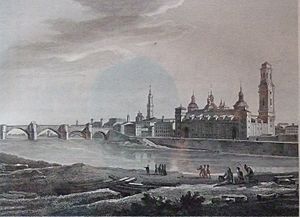
The Romanesque church was damaged by a fire in 1434. After that, rebuilding started in the Mudéjar Gothic style. A Gothic-style church was built in the 15th century. Only a few parts of it remain today, or were later fixed up. These include the choir area and a beautiful altarpiece made of alabaster by Damián Forment.
The Current Church
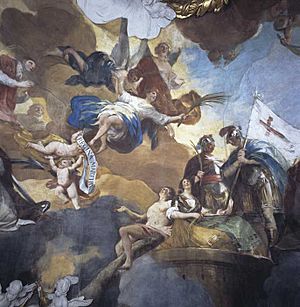
The large church you see today, in the Baroque style, began construction in 1681. Charles II, King of Spain, started the project, and it was mostly finished by 1686. The first parts were overseen by Felipe Sánchez. Later, Francisco Herrera the Younger made changes. In 1725, the church leaders in Zaragoza decided to change the look of the Holy Chapel. They hired the architect Ventura Rodríguez. He made the building much bigger, to its current size of 130 meters long and 67 meters wide. It now has eleven domes and four towers.
The most visited part of the church is the eastern side of the chapel. This is where the Holy Chapel, designed by Ventura Rodríguez in 1754, is located. It holds the special image of the Virgin Mary. Around the Holy Chapel, you can see domes painted with amazing pictures by Francisco Goya. These include The Queen of Martyrs and Adoration of the Name of God. Goya's father, José, helped design the gold decorations throughout the building. By 1718, the church's main arched ceilings were done. However, the very last parts, like the main dome and the final spire, were not finished until 1872.
During the Spanish Civil War (1936–1939), three bombs were dropped on the church. Luckily, none of them exploded. Two of these bombs are still on display inside the basilica today.
The Pillar and the Statue

The statue of Mary is made of wood and is 39 centimeters tall. It stands on a column made of jasper stone.
The tradition of the shrine of El Pilar says that Mary was carried on a cloud by angels to Zaragoza during the night. While they traveled, the angels built a pillar of marble and a tiny statue of Mary. Mary gave her message to Saint James. She also said that a church should be built where she appeared. The pillar and the statue were to be part of the main altar. The statue was given a special crown in 1905. This crown was designed by the Marquis of Griñi.
How the Building is Designed
The basilica is a very large rectangle. It has a main area (nave) and two side areas (aisles). It also has two chapels made of brick, which gives it a special look from the Aragon region. Large round windows, called oculi, let light into the building. These windows are common in buildings from this region since the 1600s. Twelve huge pillars hold up the arched ceilings of the main and side areas. The whole building, including the chapels, is topped with domes.
Some of the chapels inside the basilica include:
- Chapel of the Rosary
- Chapel of Joachim
- Chapel of Saint Lawrence
- Chapel of Saint Pedro de Arbués
- Chapel of Saint Braulio
- Chapel of Saint Anthony
- Chapel of Saint Joseph
- Chapel of Saint Anna
- Chapel of Saint John
Music and Organs
The first organ in the church was built in 1463. Later, in 1537, another organ was built to be as good as the one in the nearby La Seo Cathedral.
Between 1595 and 1602, Guillermo de Lupe and his son Gaudioso rebuilt the larger organ. They had also worked on an organ in the La Seo Cathedral in 1577.
By 1657, the church had several organs of different sizes. This meant there was a lot of musical activity, especially during the Spanish Golden Age. However, this musical tradition started to slow down in the late 1800s.
In the Middle Ages, a musician called a minstrel played a dulcian (a type of wind instrument) to go along with the singers. Later, in the mid-1600s, records show that more complex music with many voices (polyphony) was played. This involved a "tenor" and a "contrabajón" (a type of bass instrument). By the late 1600s, a group of minstrels agreed to work for the church, which was the building before the current basilica.
El Pilar and Spanish Culture
The special day for Our Lady of the Pillar is October 12. This day celebrates Mary's first appearance to Hispanic people. It also happens to be the same day as Día de la Hispanidad, which celebrates Hispanic heritage, and the date Columbus discovered the New World. Every country with Hispanic roots has given special clothes for the 15th-century statue of the Virgin. This statue is kept in the chapel. Pope John Paul II called El Pilar "Mother of the Hispanic Peoples" during his visits to the basilica.
The basilica was named a Bien de Interés Cultural (a site of cultural interest) in 1904.
See also
 In Spanish: Catedral basílica de Nuestra Señora del Pilar (Zaragoza) para niños
In Spanish: Catedral basílica de Nuestra Señora del Pilar (Zaragoza) para niños
- Marian apparitions
- Roman Catholic Marian churches
- 12 Treasures of Spain
- List of Bien de Interés Cultural in the Province of Zaragoza


